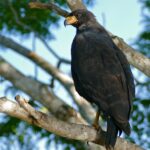Great black hawks are birds of prey that are found in the tropical New World, from Mexico through Central America to Peru, Tobago, and northern Argentina. These majestic birds are known for their distinctive black plumage, broad wings, and short tails with a white base and black tip.
Nesting Habitat of Great Black Hawks
Great black hawks are primarily coastal birds, but they also inhabit forests and open woodlands near water sources. When it comes to their nesting sites, these birds prefer to build their nests high up in emergent trees or on power poles.
Nest Construction
The great black hawk’s nest is a large, bulky structure made of sticks, twigs, and other natural materials. The female is responsible for constructing the nest, which can be quite an impressive feat, as these nests can measure up to 3 feet in diameter and 2 feet in depth.
Egg Laying and Incubation
Once the nest is complete, the female great black hawk will lay a single egg, which is white with red to purplish brown markings. The eggs must be incubated for a period of 35-37 days before they hatch. During this time, the male will work tirelessly to provide the female with enough food to sustain herself and the developing chick.
Nestling Growth and Development
After the egg hatches, the nestling will grow quickly, thanks to the dedicated efforts of both the male and female parents. The male will continue to bring a steady supply of food to the nest, ensuring that the chick has the necessary nutrients to thrive.
Hunting Behavior and Diet
 Image source: Great Black Hawk by Bernard DUPONT
Image source: Great Black Hawk by Bernard DUPONT
Great black hawks are versatile hunters, known for their creative strategies when it comes to capturing prey. They have been observed wading in shallow water and fluttering their wings to startle fish and other small vertebrates into shallower areas, where they can more easily catch them.
Prey Preferences
These birds of prey have a diverse diet, feeding on a variety of small animals, including reptiles, other small vertebrates, and large insects. They have also been known to raid the nests of hoatzins, a unique bird species found in the Amazon region, in search of eggs and chicks.
Conservation Status and Threats
The great black hawk is currently classified as a species of Least Concern by the International Union for Conservation of Nature (IUCN). However, they may face some threats, such as habitat loss and shooting in certain areas.
Habitat Loss
As with many species, the great black hawk’s population may be impacted by the loss of its preferred nesting and foraging habitats, which can occur due to factors like deforestation, urbanization, and agricultural expansion.
Shooting and Persecution
In some regions, great black hawks may be targeted by hunters or persecuted due to perceived threats to livestock or other wildlife. This can have a negative impact on their overall population numbers.
Conclusion
The great black hawk is a fascinating and adaptable bird of prey that plays a vital role in the ecosystems of the tropical New World. By understanding their nesting habits, hunting behaviors, and conservation status, we can better appreciate and protect these magnificent raptors for generations to come.


